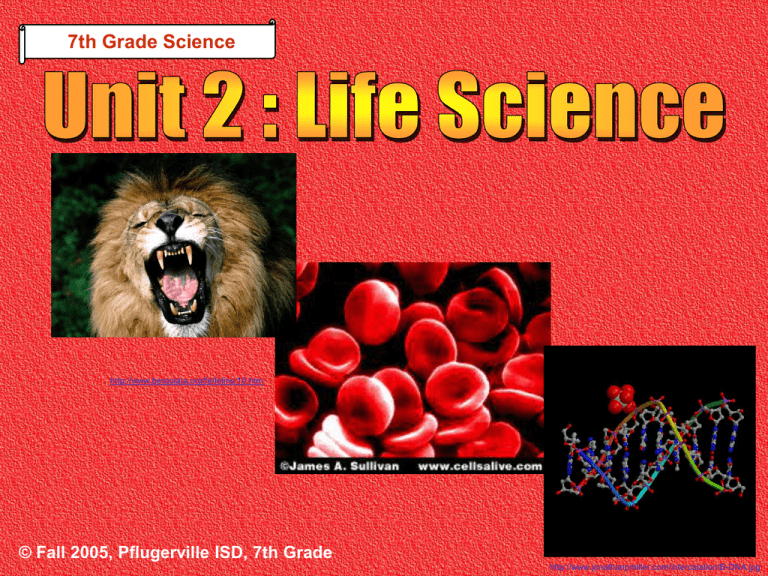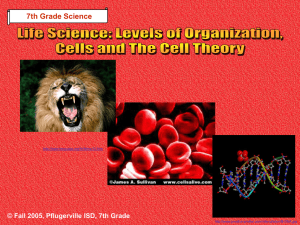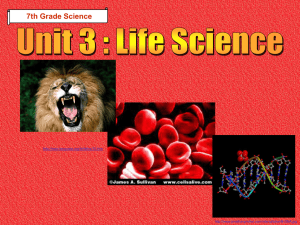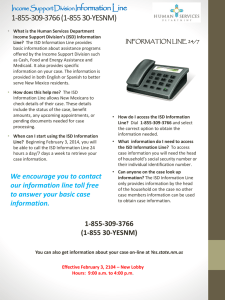Unit 2 - Chapters 7, 8
advertisement

7th Grade Science http://www.bergoiata.org/fe/felins/10.htm © Fall 2005, Pflugerville ISD, 7th Grade http://www.jonathanpmiller.com/intercalation/B-DNA.jpg Unit 2: Life Science Chapter 7: It’s Alive!! Or, Is It? Section 1: Characteristics of Living Things Section 2:The Simple Bare Necessities of Life Chapter 8: The Cell In Action Section 1: Exchange with the Environment Section 2:Energy for the Cell © Fall 2005, Pflugerville ISD, 7th Grade Unit 2 : Chapters 7,8,9,10,14 It’s Alive!! Or, Is It? What Do You Think? What characteristics do all living things have in common? © Fall 2005, Pflugerville ISD, 7th Grade Unit 2 : Chapter 7 : Section 1 It’s Alive!! Or, Is It? There are Six Characteristics of Living Things. 1. Living things have Cells. 2. Living things Sense and Respond to Change. 3. Living things have DNA. 4. Living things Reproduce. 5. Living things use Energy. 6. Living things Grow and Develop. © Fall 2005, Pflugerville ISD, 7th Grade Unit 2 : Chapter 7 : Section 1 It’s Alive!! Or, Is It? • An object must possess all 6 of the characteristics in order for it to be considered a living thing. © Fall 2005, Pflugerville ISD, 7th Grade Unit 2 : Chapter 7 : Section 1 It’s Alive!! Or, Is It? 1. Living Things Have Cells • • • • Every living thing is made up of one or more cells. Cells are the simplest collection of matter which has all the properties of life. Some cells specialize to do specific jobs. Examples are nerve cells, muscle cells, etc… © Fall 2005, Pflugerville ISD, 7th Grade Unit 2 : Chapter 7 : Section 1 It’s Alive!! Or, Is It? 2. Living Things Sense and Respond to Change. • A stimulus is a change that causes the activity of an organism to change. • A stimulus can be internal (from inside). – Examples are fever or vomiting when sick. • A stimulus can be external (from outside). – Example is squinting when the lights are bright. © Fall 2005, Pflugerville ISD, 7th Grade Unit 2 : Chapter 7 : Section 1 It’s Alive!! Or, Is It? 2. Living Things Sense and Respond to Change (cont…). • Homeostasis is the maintenance of a stable internal environment. - Our bodies are very good at controlling the chemical reactions that keep us alive. These reactions can only take place when conditions are exactly right. - Even though our outside conditions may change, homeostasis keeps our internal conditions the same. - Example is body temperature. © Fall 2005, Pflugerville ISD, 7th Grade Unit 2 : Chapter 7 : Section 1 It’s Alive!! Or, Is It? 3. Living Things Have DNA. • • • DNA stands for deoxyribose nucleic acid. DNA is the molecule that controls the functions of a cell. DNA is passed from parent to offspring. © Fall 2005, Pflugerville ISD, 7th Grade Unit 2 : Chapter 7 : Section 1 It’s Alive!! Or, Is It? 4. Living Things Reproduce. • • • Most living things reproduce by sexual reproduction. Sexual reproduction requires two parents that produce offspring that share characteristics of both parents. Sexual reproduction produces more diverse more diverse offspring. Animals http://www.jpbutler.com/thailand/images/elephant-and-baby.jpg © Fall 2005, Pflugerville ISD, 7th Grade Unit 2 : Chapter 7 : Section 1 It’s Alive!! Or, Is It? 4. Living Things Reproduce (cont…). • • • Some things reproduce by asexual reproduction. Asexual reproduction occurs when a single parent produces offspring that are exactly the same as the parent. This leads to more uniform offspring. Hydra http://universe-review.ca/I10-26-hydra.jpg © Fall 2005, Pflugerville ISD, 7th Grade Unit 2 : Chapter 7 : Section 1 It’s Alive!! Or, Is It? Click on the video below to see some differences between sexual and asexual reproduction. © Fall 2005, Pflugerville ISD, 7th Grade Unit 2 : Chapter 7 : Section 1 It’s Alive!! Or, Is It? 5. Living Things Use Energy • • Metabolism is the total of all of the chemical activities that the organisms performs. Metabolism includes: - Making food. - Breaking down food. - Building cells. - Moving materials in and out of cells. http://www.faculty.ucr.edu/~insects/systems/metabolism/metabolism.gif © Fall 2005, Pflugerville ISD, 7th Grade Unit 2 : Chapter 7 : Section 1 It’s Alive!! Or, Is It? Click below to see how living things use energy. www.unitedstreaming.com © Fall 2005, Pflugerville ISD, 7th Grade Unit 2 : Chapter 7 : Section 1 It’s Alive!! Or, Is It? 6. Living Things Grow and Develop. • • • You grow as your body gets bigger. Developing is the process of changing, maturing, and going through different stages. Growing and developing depends on the environment and the resources available. © Fall 2005, Pflugerville ISD, 7th Grade Unit 2 : Chapter 7 : Section 1 It’s Alive!! Or, Is It? Visit the website below to distinguish between Living and Non-living things. Ready? Living and Non-living things © Fall 2005, Pflugerville ISD, 7th Grade Unit 2 : Chapter 7 : Section 1 Let’s Review! -1- If the weather is cold outside, how do you maintain your body temperature? © Fall 2005, Pflugerville ISD, 7th Grade Unit 2 : Chapter 7 : Section 1 Answer • If it’s too cold, you will shiver to create heat. Humans can add layers of clothes to keep warm in the cold. Reptiles bask in the sun to stay warm. Homeostasis allows us to do this. http://www.utexas.edu/opa/news/02newsreleases/nr_200205/graphics/turtle2.jpg © Fall 2005, Pflugerville ISD, 7th Grade Unit 2 : Chapter 7 : Section 1 Let’s Review -2- • What characteristics of living things does a river have? • Is a river alive? © Fall 2005, Pflugerville ISD, 7th Grade Unit 2 : Chapter 7 : Section 1 Answer • A river has energy (it moves) and can grow larger (after rain), but it is not alive because it is not made of cells, cannot respond to stimuli, has no DNA, and cannot reproduce. © Fall 2005, Pflugerville ISD, 7th Grade Unit 2 : Chapter 7 : Section 1 It’s Alive!! Or, Is It? Websites to Visit • Cells Alive • Prokaryotes and Eukaryotes © Fall 2005, Pflugerville ISD, 7th Grade Unit 2 : Chapter 7 : Section 1 It’s Alive!! Or, Is It? What Do You Think? What are several thing that are necessary for living things to survive? © Fall 2005, Pflugerville ISD, 7th Grade Unit 2 : Chapter 7 : Section 2 It’s Alive!! Or, Is It? • Food • Water • Air • A place to live © Fall 2005, Pflugerville ISD, 7th Grade Unit 2 : Chapter 7 : Section 2 It’s Alive!! Or, Is It? Food There are 2 ways to get food. 1. Make your own food a. Producers make their own food through photosynthesis. - Plants are producers. © Fall 2005, Pflugerville ISD, 7th Grade Unit 2 : Chapter 7 : Section 2 It’s Alive!! Or, Is It? Food continued… 2. Take food a. Consumers must get (eat) their food from other organisms to get energy. - Example is an animal. b. Decomposers break down nutrients in dead organisms or in animal wastes. - Example is an earthworm. © Fall 2005, Pflugerville ISD, 7th Grade Unit 2 : Chapter 7 : Section 2 It’s Alive!! Or, Is It? Click the link below to see an Interactive Food Chain. Food Chains http://www.warwick.surrey.sch.uk/student%20zone/GCSE%20Science%20Website/03%20Environment%20Food%20Chains.htm © Fall 2005, Pflugerville ISD, 7th Grade Unit 2 : Chapter 7 : Section 2 It’s Alive!! Or, Is It? Water • Our bodies are made of almost 70% water. In order for chemical reactions that are involved in the process of metabolism to occur, we must have plenty of water in our body. © Fall 2005, Pflugerville ISD, 7th Grade Unit 2 : Chapter 7 : Section 2 It’s Alive!! Or, Is It? • Click below to see examples of animals needing water to survive. www.unitedstreaming.com © Fall 2005, Pflugerville ISD, 7th Grade Unit 2 : Chapter 7 : Section 2 It’s Alive!! Or, Is It? Air • Most living things need oxygen for the chemical processes that release energy from food. • Organisms that live on land get the oxygen from the air. • Organisms living in water either use dissolved oxygen from the water, or come to the water’s surface to get oxygen from the air. © Fall 2005, Pflugerville ISD, 7th Grade Unit 2 : Chapter 7 : Section 2 It’s Alive!! Or, Is It? Air continued… Click below to see how different organisms get the oxygen they need. The Lung Association © Fall 2005, Pflugerville ISD, 7th Grade Unit 2 : Chapter 7 : Section 2 It’s Alive!! Or, Is It? A Place to Live • All organisms must have a place to live. • Some larger organisms, such as an elephant, require a lot of space. • Smaller organisms, such as bacteria, may spend their whole lives on a single pore on the tip of your nose. © Fall 2005, Pflugerville ISD, 7th Grade Unit 2 : Chapter 7 : Section 2 Let’s Review -1Describe how producers, consumers, and decomposers live together in an environment. © Fall 2005, Pflugerville ISD, 7th Grade Unit 2 : Chapter 7 : Section 2 Answer • Producers, consumers, and decomposers make a food chain. Producers can make their own food from the sunlight. They also are food for the consumers and decomposers. Decomposers break down dead organisms into nutrients for the producers to grow in. They all need each other to survive. http://www.explorelearning.com/index.cfm?method=cResource.dspView&ResourceID=381 © Fall 2005, Pflugerville ISD, 7th Grade Unit 2 : Chapter 7 : Section 2 It’s Alive!! Or, Is It? How the Body Uses O2 Make Your Own Food Web! © Fall 2005, Pflugerville ISD, 7th Grade Unit 2 : Chapter 7 : Section 2 It’s Alive!! Or, Is It? Pre-AP Extensions for Chapter 7 There are 2 main types of cells. 1. Prokaryotic Cells - have no nucleus - found in the kingdom of Monera - Examples are bacteria. http://library.thinkquest.org/C004535/media/prokaryote.gif © Fall 2005, Pflugerville ISD, 7th Grade Unit 2 : Chapter 7 : Pre-AP It’s Alive!! Or, Is It? Pre-AP Extensions for Chapter 7 There are 2 main types of cells (cont…). 2. Eukaryotic cells - have a true nucleus (that contains DNA) - found in more complex kingdoms (animal, plant, etc…) http://www.ccnmtl.columbia.edu/projects/biology/lecture1/images/F04071s.jpg © Fall 2005, Pflugerville ISD, 7th Grade Unit 2 : Chapter 7 : Pre-AP It’s Alive!! Or, Is It? Pre-AP Extensions for Chapter 7 Click below for an interactive tour of prokaryotic (bacteria) and eukaryotic (plant and animal) cells. Prokaryotic and Eukaryotic Cells © Fall 2005, Pflugerville ISD, 7th Grade Unit 2 : Chapter 7 : Pre-AP It’s Alive!! Or, Is It? Pre-AP Extensions for Chapter 7 Classification Websites to Visit Taxonomy of Living Things Classification and Taxonomy © Fall 2005, Pflugerville ISD, 7th Grade Unit 2 : Chapter 7 : Pre-AP The Cell in Action What Do You Think? How do food, water, and wastes get into and out of a cell? © Fall 2005, Pflugerville ISD, 7th Grade Unit 2 : Chapter 8 : Section 1 The Cell in Action Diffusion • Materials must move into and out of the cell. This happens through the cell membrane. • Molecules travel from very crowded areas to less crowded areas. The Cell Membrane http://library.thinkquest.org/C004535/media/cell_membrane.gif © Fall 2005, Pflugerville ISD, 7th Grade Unit 2 : Chapter 8 : Section 1 The Cell in Action Diffusion continued… • The movement of particles from a high (crowded) concentration area to a low (less crowded) concentration area is called diffusion. Simple Diffusion Animation © Fall 2005, Pflugerville ISD, 7th Grade Unit 2 : Chapter 8 : Section 1 The Cell in Action Diffusion goes from an area of high concentration to low concentration http://www.biologycorner.com/resources/diffusion-animated.gif If perfume is sprayed in one corner of the room, it will take a while before the back of the room can smell it. It diffuses from a high concentration area to a low concentration area. © Fall 2005, Pflugerville ISD, 7th Grade Unit 2 : Chapter 8 : Section 1 The Cell in Action Diffusion of Water • The diffusion of water across the cell membrane is called osmosis. • In osmosis, water molecules move from an area of high concentration to an area of low concentration. © Fall 2005, Pflugerville ISD, 7th Grade Unit 2 : Chapter 8 : Section 1 The Cell in Action •Osmosis occurs when water diffuses across the cell membrane. http://www.biologycorner.com/bio1/diffusion.html# • Notice only the blue water molecules are traveling in and out of the cell © Fall 2005, Pflugerville ISD, 7th Grade Unit 2 : Chapter 8 : Section 1 The Cell in Action Moving Things In and Out of the Cell • Most things, like water and oxygen, can diffuse directly through the lipid (fat) cell membrane because they are so small. • Some things are too large (sugars) to squeeze through the cell membrane. • The things that are too big to go through the membrane use passive transport, active transport, endocytosis, and exocytosis to get through the cell. © Fall 2005, Pflugerville ISD, 7th Grade Unit 2 : Chapter 8 : Section 1 The Cell in Action Passive Transport • This is the process of moving medium sized particles across the cell membrane. • This process happens when molecules diffuse from an area of high concentration to an area of low concentration. • No energy is used- molecules just squeeze through the proteins in the cell membrane. © Fall 2005, Pflugerville ISD, 7th Grade Unit 2 : Chapter 8 : Section 1 The Cell in Action Moving Medium Sized Particles Across the Cell Membrane •Notice the red molecules going from a high to low concentration area. •NO energy was used…the molecules just squeezed through the cell membrane. Go.hrw.com © Fall 2005, Pflugerville ISD, 7th Grade Unit 2 : Chapter 8 : Section 1 The Cell in Action Active Transport • This is the process of moving medium sized particles across the membrane. • This is the movement of substances through proteins against the normal direction of diffusion. • Molecules are moved from an area of low concentration to a high concentration area. • Energy IS required. © Fall 2005, Pflugerville ISD, 7th Grade Unit 2 : Chapter 8 : Section 1 The Cell in Action Moving Medium Sized Particles Across the Cell Membrane •The red molecules are moving from a low to high concentration area. •Energy is required! Go.hrw.com © Fall 2005, Pflugerville ISD, 7th Grade Unit 2 : Chapter 8 : Section 1 The Cell in Action Moving larger particles across the cell membrane • Endocytosis is the process of bringing larger particles into the cell. http://www.biologycorner.com/bio1/active.html © Fall 2005, Pflugerville ISD, 7th Grade Unit 2 : Chapter 8 : Section 1 The Cell in Action Moving larger particles across the cell membrane • Exocytosis is the process of moving large wastes products from inside the cell out of the cell. http://bio.winona.edu/berg/ANIMTNS/facdifan.gif © Fall 2005, Pflugerville ISD, 7th Grade Unit 2 : Chapter 8 : Section 1 Let’s Review -1How does a cell take in large particles? How does a cell get rid of large particles? © Fall 2005, Pflugerville ISD, 7th Grade Unit 2 : Chapter 8 : Section 1 Answer • Large particles are taken in by endocytosis and expelled by exocytosis. © Fall 2005, Pflugerville ISD, 7th Grade Unit 2 : Chapter 8 : Section 1 The Cell in Action What Do You Think? How are photosynthesis and cellular respiration similar? © Fall 2005, Pflugerville ISD, 7th Grade Unit 2 : Chapter 8 : Section 2 The Cell in Action Photosynthesis • Takes place in the chloroplasts of plant cells • Carbon dioxide and water are used, in the presence of sunlight, to make glucose (food) and oxygen. © Fall 2005, Pflugerville ISD, 7th Grade http://lhs.lps.org/staff/sputnam/Biology/U3Cell/chloroplast_1.png Unit 2 : Chapter 8 : Section 2 The Cell in Action Click below to learn more about photosynthesis. © Fall 2005, Pflugerville ISD, 7th Grade Unit 2 : Chapter 8 : Section 2 The Cell in Action Cellular Respiration • Cellular respiration is the http://www.wappingersschools.org/RCK/staff/teacherhp/johnson/visualvocab/cellresp.jpg © Fall 2005, Pflugerville ISD, 7th Grade breakdown of food, like glucose, using oxygen. • Uses glucose and oxygen to make carbon dioxide and water. • Often confused as “breathing”. Not the same! Breathing gives our cells the oxygen needed for cellular respiration. Unit 2 : Chapter 8 : Section 2 The Cell in Action Click below to learn more about cellular respiration. © Fall 2005, Pflugerville ISD, 7th Grade Unit 2 : Chapter 8 : Section 2 The Cell in Action Make a Venn diagram comparing and contrasting photosynthesis and cellular respiration. © Fall 2005, Pflugerville ISD, 7th Grade Unit 2 : Chapter 8 : Section 2 Let’s Review! -1Why are producers (who use photosynthesis) important to the survival of all other organisms? © Fall 2005, Pflugerville ISD, 7th Grade Unit 2 : Chapter 8 : Section 2 Answer • Producers harness energy in sunlight to produce food (glucose). This food becomes an energy source for producers and for the organisms that consume them. © Fall 2005, Pflugerville ISD, 7th Grade Unit 2 : Chapter 8 : Section 2 The Cell in Action Websites to Visit Good Diffusion Labs! Transport In and Out of Cells Photosynthesis Cellular Respiration © Fall 2005, Pflugerville ISD, 7th Grade Unit 2 : Chapter 8 The Cell in Action Pre-AP Extensions for Chapter 8 There are 2 types of endocytosis. Each process bring particles into the cell. 1. Pinocytosis 2. Phagocytosis © Fall 2005, Pflugerville ISD, 7th Grade Unit 2 : Chapter 8 : Pre-AP The Cell in Action Pre-AP Extensions for Chapter 8 1. Pinocytosis involves ingesting small molecules and/or fluids surrounding the cell. • The cell membrane surrounds and “pinches off” small droplets and places them in a vesicle inside the cell. • Most of the molecules are already dissolved in a solution during pinocytosis. © Fall 2005, Pflugerville ISD, 7th Grade Unit 2 : Chapter 8 : Pre-AP The Cell in Action Pre-AP Extensions for Chapter 8 Pinocytosis •The small molecules are ingested by the cell membrane and used inside the cell. http://www.cat.cc.md.us/courses/bio141/lecguide/unit2/eustruct/pinocyt.html © Fall 2005, Pflugerville ISD, 7th Grade Unit 2 : Chapter 8 : Pre-AP The Cell in Action Pre-AP Extensions for Chapter 8 The second type of endocytosis is called phagocytosis. • Phagocytosis is the process of surrounding, engulfing, and digesting larger, microscopically visible particles. • Phagocytosis is used by most protozoans to get food. http://www.oum.ox.ac.uk/children/animals/protists.gif © Fall 2005, Pflugerville ISD, 7th Grade Unit 2 : Chapter 8 : Pre-AP The Cell in Action Pre-AP Extensions for Chapter 8 Phagocytosis •In phagocytosis, the food particle is too big to “absorb” through the cell membrane. It must be surrounded and engulfed. http://academic.brooklyn.cuny.edu/biology/bio4fv/page/phago.htm © Fall 2005, Pflugerville ISD, 7th Grade Unit 2 : Chapter 8 : Pre-AP





